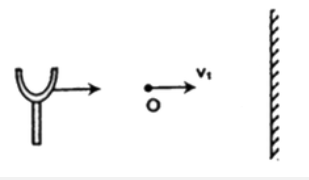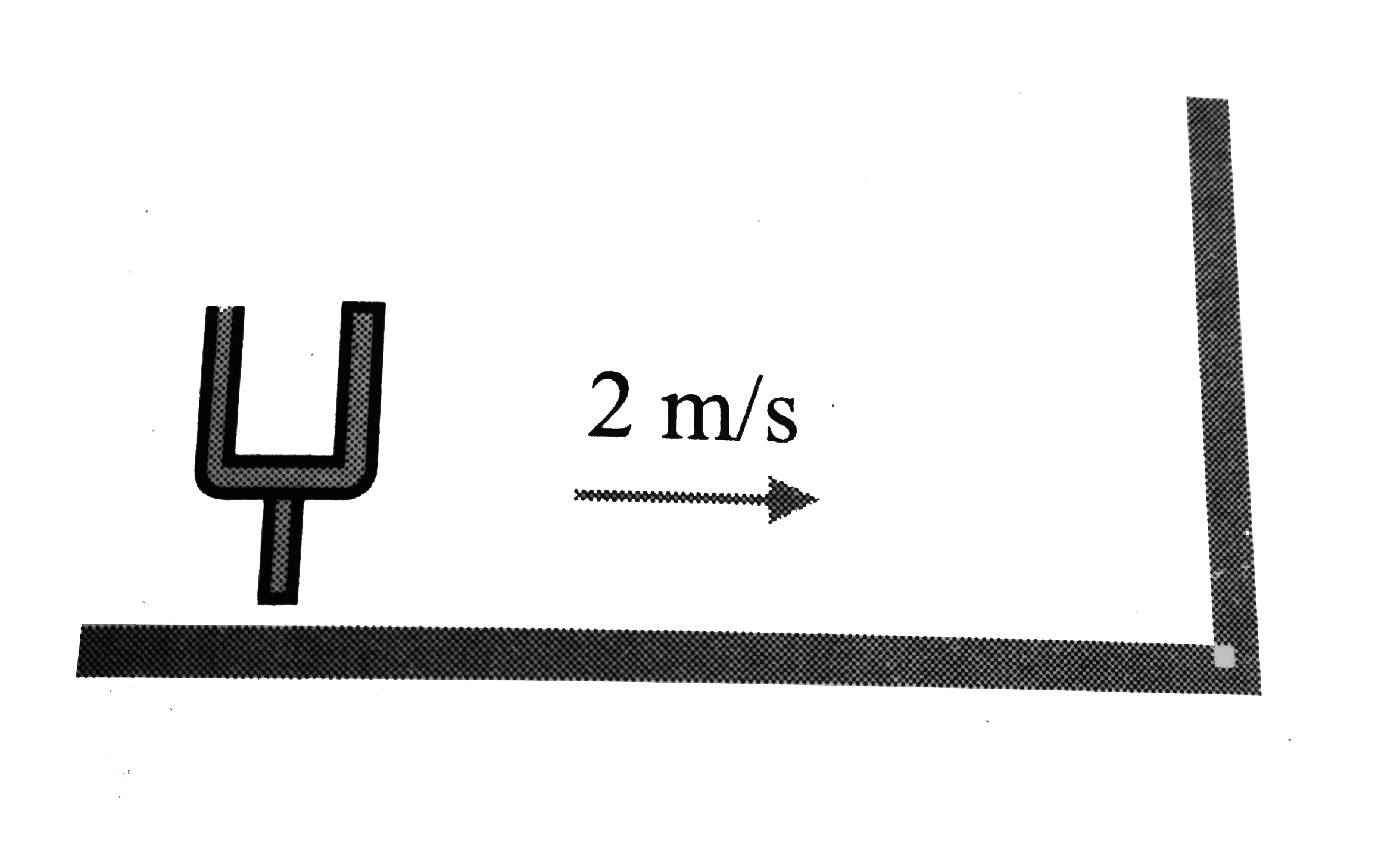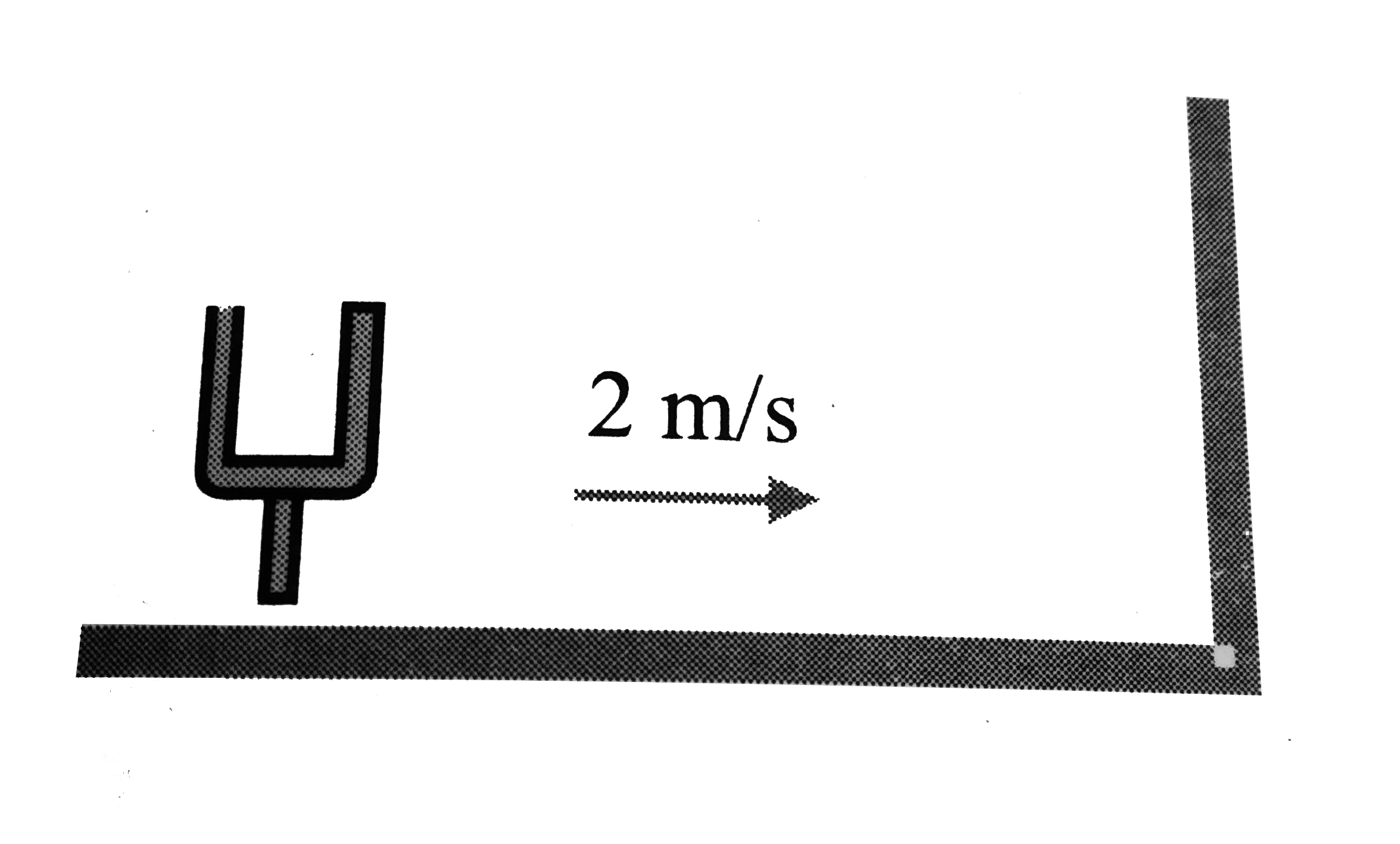A student holds a tuning fork ocillating at 2456 Hz. He walks towards a wall at a constant speed of 1.33ms. (a) What beat frequency does the student observes between the tuning fork and its echo? (b) How fast must he walk away from the wall to observe a beat frequency of 5.00Hz?
An electronic burglar detector may listen for beasts between the signal it broadcasts and the Doppler shifted reflection from a moving surface. The experiment described here is more fun. The student hears beats at a rate that is controlled through his walking speed. We must thinks of a double Doppler shift, for the wave reaching the wall from the moving tuning fork and the wave reaching the moving auditor.
For this echo,
freceived back=rradiantedv+vev−ve
where ve is the magnitude of the experimenter's velocity the beat frequency is
fb=|freceived back−fradiated|
Substituting gives
fb=fradiated(2ve)v−ve
When approaching the wall
a. fb=(256Hz)2(1.33ms)343ms−1.33ms=1.99Hz
b. When moving away from wall ve appears with opposite signs, Solving for ve gives
ve=fb(v)2fradiated−fb
=(5.00Hz)[343ms2(256Hz)−5.00Hz]=3.38ms
Topper's Solved these Questions
- SOUND WAVES AND DOPPLER EFFECTBOOK - CENGAGE PHYSICS ENGLISHCHAPTER - SOUND WAVES AND DOPPLER EFFECTEXERCISE - Exercise 6.1
56 Videos
- SOUND WAVES AND DOPPLER EFFECTBOOK - CENGAGE PHYSICS ENGLISHCHAPTER - SOUND WAVES AND DOPPLER EFFECTEXERCISE - Exercise 6.2
72 Videos
- SOUND WAVES AND DOPPLER EFFECTBOOK - CENGAGE PHYSICS ENGLISHCHAPTER - SOUND WAVES AND DOPPLER EFFECTEXERCISE - Integer
16 Videos
- RIGID BODY DYNAMICS 2BOOK - CENGAGE PHYSICS ENGLISHCHAPTER - RIGID BODY DYNAMICS 2EXERCISE - Interger
2 Videos
- SUPERPOSITION AND STANDING WAVESBOOK - CENGAGE PHYSICS ENGLISHCHAPTER - SUPERPOSITION AND STANDING WAVESEXERCISE - Comprehension Type
5 Videos
Similar Questions
A car blowing a horn of frequency 350 Hz is moving normally towards a wall a speed of 5 m/s The beat frequency heard by a person standing between the car and wall is (speed of sound in air =350 m/s )
View SolutionThere is a source of sound (a tuning fork) moving towards a reflecting wall will a speed of 30ms−1. The velocity of the sound in air is 330ms−1and the frequency of the tuning fork is 600 Hz. The observer is between the source and the wall and is moving with some velocity V1 towards the wall. The beat frequency heard by the observer is 4 Hz. If the tuning fork is waxed, the frequency beats heard by the observer becomes 3 Hz. If the new frequency of tuning fork is k then k/50 is

View Solution
As shown if Fig. a vibrating tuning fork of frequency 512 Hz is moving towards the wall with a speed 2ms. Take speed of sound as v=340ms and answer the following questions.
Q. Suppose that a listener is located at rest between the tuning fork and the wall. Number of beats heard by the listener per second will be
View Solution
As shown if Fig. a vibrating tuning fork of frequency 512 Hz is moving towards the wall with a speed 2ms. Take speed of sound as v=340ms and answer the following questions.
Q. Suppose that a listener is located at rest between the tuning fork and the wall. Number of beats heard by the listener per second will be
View SolutionA tuning fork of frequency 256hZ is moving towards a well with a velocity of 5m/s . If the speed of sound is 330m/s , then the number of beats heard per second by a stationary observer lying between tuning fork and the well is
View SolutionA source of sound with frequency 256Hz is moving with a velocity V towards a wall and an observer is stationary between the source and the wall. When the observer is between the source and the wall will he hear beats?
View SolutionA source of sound with frequency 256Hz is moving with a velocity V towards a wall and an observer is stationary between the source and the wall. When the observer is between the source and the wall he will hear beats.
View SolutionA turning fork vibrating at 500Hz falls from rest accelerates at 10m/s2.
How far below the point of release is the tuning fork when wave with a frequency of 475Hz reach the release point ?
View SolutionTwo tuning forks produce 4 beats per seconds when they are sounded together. Now both the forks are moved towards the observer at same speed (u). The beat frequency now becomes 5Hz. If the observer also beings to run with speed u towards both the forks, then beat frequency is.
View Solution
As shown if Fig. a vibrating tuning fork of frequency 512 Hz is moving towards the wall with a speed 2ms. Take speed of sound as v=340ms and answer the following questions.
Q. If the listener is at rest and located such that the tuning fork is moving between the listener and the wall, number of beats heard by the listerner per second will be nearly
View Solution
